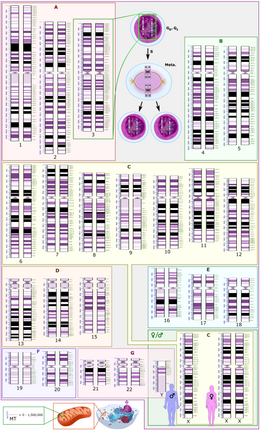
Back جينوم بشري Arabic Xenoma humanu AST İnsan xromosomları Azerbaijani Човешки геном Bulgarian মানব বংশাণুসমগ্র Bengali/Bangla Ljudski genom BS Genoma humà Catalan Lidský genom Czech Çын геномĕ CV Y genom dynol Welsh
 Schematic representation of the human diploid karyotype, showing the organization of the genome into chromosomes, as well as annotated bands and sub-bands as seen on G banding. This drawing shows both the female (XX) and male (XY) versions of the 23rd chromosome pair. Chromosomal changes during the cell cycle are displayed at top center. The mitochondrial genome is shown to scale at bottom left. |
The human genome is a complete set of nucleic acid sequences for humans, encoded as the DNA within each of the 24 distinct chromosomes in the cell nucleus. A small DNA molecule is found within individual mitochondria. These are usually treated separately as the nuclear genome and the mitochondrial genome.[1] Human genomes include both protein-coding DNA sequences and various types of DNA that does not encode proteins. The latter is a diverse category that includes DNA coding for non-translated RNA, such as that for ribosomal RNA, transfer RNA, ribozymes, small nuclear RNAs, and several types of regulatory RNAs. It also includes promoters and their associated gene-regulatory elements, DNA playing structural and replicatory roles, such as scaffolding regions, telomeres, centromeres, and origins of replication, plus large numbers of transposable elements, inserted viral DNA, non-functional pseudogenes and simple, highly repetitive sequences. Introns make up a large percentage of non-coding DNA. Some of this non-coding DNA is non-functional junk DNA, such as pseudogenes, but there is no firm consensus on the total amount of junk DNA.
Although the sequence of the human genome has been completely determined by DNA sequencing in 2022 (including methylome), it is not yet fully understood. Most, but not all, genes have been identified by a combination of high throughput experimental and bioinformatics approaches, yet much work still needs to be done to further elucidate the biological functions of their protein and RNA products.
- ^ Brown TA (2002). The Human Genome (2nd ed.). Oxford: Wiley-Liss.